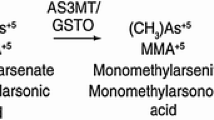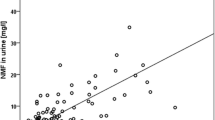Abstract
Purpose
Exposure to diisocyanates is a known occupational hazard. One method for monitoring occupational exposure is by analyzing biomarkers in hydrolyzed urine and plasma. The half-life of the biomarkers in plasma is about 3 weeks, and the urinary elimination is divided into one fast (hours) and one slow phases (weeks). Polymorphism in glutathione S-transferase enzymes (GST) is earlier shown to modify the metabolism. The aim of the study was to assess whether biomarkers of exposure in urine collected after two non-exposed days correlate with levels in plasma and whether they can be used as a measure for long-term exposure to aromatic diisocyanates and further whether polymorphisms in GST influenced the correlations.
Methods
Biomarkers of exposure was analyzed in urine and blood samples collected from 24 workers, exposed to at least one of toluene-, methylenediphenyl- or naphthalene diisocyanate, on a Monday morning after at least two unexposed days. Moreover, genotype was determined for 19 of the workers.
Results
The corresponding specific gravity-adjusted biomarkers in urine and plasma levels for the different diisocyanates correlated well (r between 0.689 and 0.988). When taking all samples together, the correlation coefficient was 0.926. Polymorphism in the GSTM1 genotype seemed to modify the association.
Conclusion
Urine collected after two unexposed days can possibly be used as long-term biomarker of exposure for aromatic diisocyanates.



Similar content being viewed by others
References
Altman DG (1991) Diagnostics test. In: Practical statistics for medical research. London, Chapman and Hall, pp 414–419
Bakerly ND, Moore VC, Vellore AD, Jaakkola MS, Robertson AS, Burge PS (2008) Fifteen-year trends in occupational asthma: data from the Shield surveillance scheme. Occup Med 58:169–174
Boeniger MF, Lowry LK, Rosenberg J (1993) Interpretation of urine results used to assess chemical exposure with emphasis on creatinine adjustment: a review. Am Ind Hyg Assoc J 54:615–627
Broberg K, Tinnerberg H, Axmon A, Warholm M, Rannug A, Littorin M (2008) Influence of genetic factors on toluene diisocyanate-related symptoms. Environ Health 7:15
Broberg K, Littorin M, Axmon A, Jönsson BAG, Sennbro CJ, Tinnerberg H, Warholm M, Rannug A (2010) The GSTP1 Ile 105 val polymorphism modifies the metabolism of toluene diisocyanate (TDI). Pharmacogenet Genom 20:104–111
Brorson T, Skarping G, Sangö C (1991) Biological monitoring of isocyanates and related amines—Part IV: 2,4- and 2,6-toluenediamine in plasma and urine after test-chamber exposure of humans to 2,4- and 2,6-toluene diisocyanate. Int Arch Occup Environ Health 63:253–259
Budnik LT, Nowak D, Merger R, Lemiere C, Baur X (2011) Elimination kinetics of diisocyanates after specific inhalative challenges in humans: mass spectrometry analysis, as a basis for biomonitoring strategies. J Occup Med Toxicol 6:9
Dalene M, Skarping G, Lind P (1997) Workers exposed to thermal degradation products of TDI- and MDI-based polyurethane: biomonitoring of 2,4-TDA, 2,6-TDA and 4,4′-MDA in hydrolyzed urine and plasma. Am Ind Hyg Assoc J 58:587–591
Day BW, Jin R, Basalyga DM, Kramarik JA, Karol MH (1997) Formation, solvolysis, and transcarbamoylation reactions of bis(s-glutathionyl) adducts of 2,4- and 2,6-diisocyanatotoluene. Chem Res Toxicol 10:424–431
Henriks-Eckerman ML, Välimää J, Rosenberg CK, Peltonen K, Engström K (2002) Exposure to airborne isocyanates and other thermal degradation products at polyurethane-processing workplaces. J Environ Monit 4:717–721
Johannesson G, Sennbro CJ, Willix P, Lindh CH, Jönsson BAG (2004) Identification and characterization of adducts between serum albumin and MDI in human plasma. Arch Toxicol 78:378–383
Kääriä K, Hirvonen A, Norppa H, Piirilä P, Vainio H, Rosenberg C (2001a) Exposure to 2,4- and 2,6-toluene diisocyanate (TDI) during production of flexible foam: determination of airborne TDI and urinary 2,4- and 2,6-toluenediamine (TDA). Analyst 126:1025–1031
Kääriä K, Hirvonen A, Norppa H, Piirilä P, Vainio H, Rosenberg C (2001b) Exposure to 4,4′-methylenediphenyl diisocyanate (MDI) during moulding of rigid polyurethane foam: determination of airborne MDI and urinary methylene dianiline (MDA). Analyst 126:476–479
Lantz RC, Lemus R, Lange RW, Karol MH (2001) Rapid reduction of intracellular glutathione in human bronchial epithelial cells exposed to occupational levels of toluene diisocyanate. Toxicol Sci 60:348–355
Lind P, Dalene M, Skarping G (1996) Biomarkers of toluene diisocyanate and thermal degradation products of polyurethane, with special reference to the sample preparation. Anal Chim Acta 333:277–283
Lind P, Dalene M, Lindström V, Grubb A, Skarping G (1997a) Albumin adducts in plasma from workers exposed to toluene diisocyanate. Analyst 122:151–154
Lind P, Dalene M, Tinnerberg H, Skarping G (1997b) Biomarkers in hydrolysed urine, plasma and erythrocytes among workers exposed to thermal degradation products from toluene diisocyanate foam. Analyst 122:51–56
Littorin M, Rylander L, Skarping G, Dalene M, Welinder H, Strömberg U, Skerfving S (2000) Exposure biomarkers and risk of gluing and heating of polyurethane: a cross sectional study of respiratory symptoms. Occup Environ Med 57:396–405
Littorin M, Axmon A, Broberg K, Sennbro CJ, Tinnerberg H (2007) Eye and airway symptoms in low occupational exposure to toluene diisocyanate. Scand J Work Environ Health 33:280–285
Liu Y, Berode M, Stowe MH, Holm CT, Walsh FX, Slade MD, Boeniger MF, Redlich CA (2004) Urinary hexamethylene diamine to assess respiratory exposure to hexamethylene diisocyanate aerosol. Int J Occup Environ Health 10:262–271
Maitre A, Berode M, Perdrix A, Romazini S, Savolainen H (1993) Biological monitoring of occupational exposure to toluene diisocyanate. Int Arch Occup Environ Health 65:97–100
Maitre A, Berode M, Perdrix A, Stoklov M, Mallion JM, Savolainen H (1996) Urinary hexamethylene diamine as an indicator of occupational exposure to hexamethylene diisocyanate. Int Arch Occup Environ Health 69:65–68
Mapp CE, Fryer AA, De Marzo N, Pozzato V, Padoan M, Boschetto P, Strange RC, Hemmingsen A, Spiteri MA (2002) Glutathione S-transferase GSTP1 is a susceptibility gene for occupational asthma induced by isocyanates. J Allergy Clin Immunol 109:867–872
Nielsen J, Welinder H, Ottosson H, Bensryd I, Venge P, Skerfving S (1994) Nasal challenge shows pathogenetic relevance of specific IgE serum antibodies for nasal symptoms caused by hexahydrophthalic anhydride. Clin Exp Allergy 24:440–449
Piirilä P, Wikman H, Luukkonen R, Kääriä K, Rosenberg C, Nordman H, Norppa H, Vainio H, Hirvonen A (2001) Glutathione S-transferase genotypes and allergic responses to diisocyanate exposure. Pharmacogen 11:437–445
Rosenberg C, Savolainen H (1986) Determination of occupational exposure to toluene diisocyanate by biological monitoring. J Chromatogr 367:385–392
Rosqvist S, Nielsen J, Welinder H, Rylander L, Lindh CH, Jönsson BA (2003) Exposure-response relationships for hexahydrophtalic and methylhexahydrophtalic anhydrides with total plasma protein adducts as biomarkers. Scand J Work Environ Health 29:297–303
Sabbioni G, Gu Q, Vanimireddy LR (2012) Determination of isocyanate specific albumin-adducts in workers exposed to toluene diisocyanates. Biomarkers 17:150–159
Sennbro CJ, Lindh CH, Tinnerberg H, Gustavsson C, Littorin M, Welinder H, Jönsson BAG (2003) Development, validation and characterization of an analytical method for quantification of hydrolysable urinary metabolites and plasma protein adducts of 2,4- and 2,6-toluene diisocyanate, 1,5-naphthalene diisocyanate and 4,4′-methylenediphenyl diisocyanate. Biomarkers 8:204–217
Sennbro CJ, Lindh CH, Tinnerberg H, Welinder H, Littorin M, Jönsson BAG (2004) Biological monitoring of exposure to toluene diisocyanate. Scand J Work Environ Health 30:371–378
Sennbro CJ, Littorin M, Tinnerberg H, Jönsson BAG (2005) Upper reference limits for biomarkers of exposure to aromatic diisocyanates. Int Arch Occup Environ Health 78:541–546
Sennbro CJ, Lindh C, Mattsson C, Jönsson BAG, Tinnerberg H (2006) Biological monitoring of exposure to 1,5-naphthalene diisocyanate and 4,4′-methylenediphenyl diisocyanate. Int Arch Occup Environ Health 79:647–653
SWEA Swedish work environment authority (2011) AFS 2011:18 Occupational exposure limit values. Stockholm, Sweden (in Swedish)
Swensson Å, Holmquist CE, Lundgren KD (1955) Injury to the respiratory tract by isocyanates used in making lacquers. Br J Industr Med 12:50–53
Tinnerberg H, Skarping G, Dalene M, Hagmar L (1995) Test chamber exposure of humans to 1,6-hexamethylene diisocyanate and isophorone diisocyanate. Int Arch Occup Environ Health 67:367–374
Törnqvist M, Fred C, Haglund J, Helleberg H, Paulsson B, Rydberg P (2002) Protein adducts: quantitative and qualitative aspects of their formation, analysis and application. J Chromatogr B 778:279–308
Acknowledgments
Financial support for this work was obtained from the Swedish Council for Work Life and Social Research. The authors also thank Mr. Christian Mattsson, Ms. Eva Assarsson and Mrs. Karin Paulsson for skillful technical and medical assistance and the workers in the study for invaluable participation.
Conflict of interest
The authors declare that they have no conflict of interest.
Author information
Authors and Affiliations
Corresponding author
Rights and permissions
About this article
Cite this article
Tinnerberg, H., Broberg, K., Lindh, C.H. et al. Biomarkers of exposure in Monday morning urine samples as a long-term measure of exposure to aromatic diisocyanates. Int Arch Occup Environ Health 87, 365–372 (2014). https://doi.org/10.1007/s00420-013-0872-y
Received:
Accepted:
Published:
Issue Date:
DOI: https://doi.org/10.1007/s00420-013-0872-y




